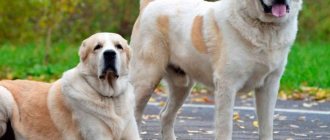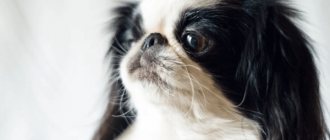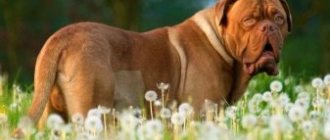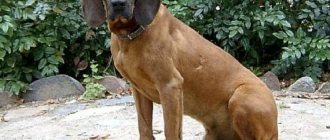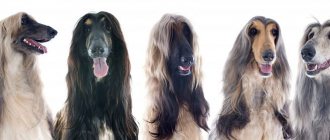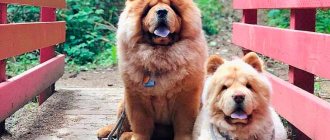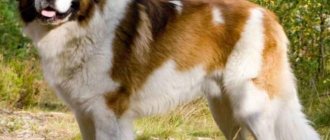Viewers often wonder what breed the dog is in the movie “Hachiko: The Most Faithful Friend.” According to a true story that happened in the Land of the Rising Sun in the last century, Hachiko's breed is Akita Inu.
The Hachiko dog breed appeared in Japan a long time ago.
It is known that the film starred not one, but three dogs, each of which played a certain stage in the life of a faithful dog. The director called the famous Richard Gere to play the main role, who was ideal for this character. Gere himself said that he liked the breed of dog in the film. “They are better than us, these dogs are simply incomparable,” these were the words of the actor after filming.
From the film "Hachiko" the viewer learns about true devotion and fidelity, about friendship between animals and humans. After the film was released on big screens in 2009, many people decided to have an Akita Inu in their homes, and the prices for puppies jumped several times.
Akita Inu has become a national treasure of the Japanese people
The Hachiko dog breed appeared in Japan a very long time ago. Local residents consider it a sacred dog, bringing good luck and happiness to its owners. After the film appeared at the worldwide box office, the popularity of this dog breed went far beyond the borders of the Land of the Rising Sun. Thus, dogs of this breed became the national treasure of the Japanese people.
The sad story of a devoted animal
It’s no secret that the events in the film about Hachiko are not the directors’ imagination, but a sad reality. This story began in the 20s of the last century in Japan. Professor Hidesamuro Ueno was given an Akita Inu puppy, and he named him Hashiko, which means eighth in Japanese (the professor already had 7 dogs up to that point). The animal began to be called Hachiko in the European manner after the whole world learned about it.
The professor taught the pet to accompany him to the railway station every morning and meet him there after lunch. Every day for 2 years, the dog came to the platform with his owner, waited for the train to disappear from sight, and then slowly returned home alone. Exactly at 15:00 he again appeared on the platform, where he joyfully greeted the arriving owner.
One day in May 1925, Hachiko and his owner, as usual, said goodbye on the platform, the train left, and the dog wandered home. After lunch, at exactly 15:00, the dog appeared on the platform, but its owner never left the approaching train. As it turned out later, the professor became ill with his heart at work, and they could not save him. But the faithful dog continued to come to the station every day for almost 10 years, looking for his owner in the crowd of people arriving. He sat on the platform in the rain, in the snow, in the hail, still hoping that the owner would appear.
Ringworm in dogs: methods of infection, signs, treatment
The dog's boundless devotion could not leave anyone indifferent. The professor's relatives and friends tried to take Hachiko home with them, but he still stubbornly walked to the platform, where he waited for his owner, and then returned to a lonely house, where he slept on the porch. Railway workers and station merchants tried in every possible way to alleviate the dog’s suffering - they saved him from the scorching sun and cold wind, and constantly fed him.
Hachiko died on March 8, 1935, he was found near the station. Since then, this day has been a day of mourning throughout Japan, and Akita Inu dogs are considered the embodiment of devotion and fidelity. Upon autopsy of the dog, it was discovered that Hachiko had terminal cancer and his cause of death was a heart attack.
In 1934, a metal monument was erected in Hachiko's honor as a symbol of boundless love and devotion.
During the Second World War, the monument had to be melted down - the metal was needed for the needs of the front. But after the war in 1948, a new monument was erected at the station where Akita Hachiko died. It still stands there today and is a meeting place for couples in love, as it is considered the personification of a true and committed relationship.
Famous dogs
From the movie "Hachiko"
The film “Hachiko” starring the Akita Inu dog won the hearts of many people. But few people know that the dog’s plight is not fictional. The story began in 1924, when the owner of the farm where Hachiko was born gave a puppy to a professor at Tokyo University. Every day, Hachiko followed his owner and waited for him near Shibuya station. On May 21, 1925, the professor suffered a stroke and died without ever returning to the station.
After death, Hachiko went to other owners, but every day he ran away to the house where his owner lived. Realizing that the owner no longer lived in this house, he returned to the station. For 10 years, Hachiko came to the station exactly at 16.00 when the train arrived and waited for his owner.
Hachiko became an example of devotion and loyalty. In his honor, a bronze statue was erected in front of the station, which has survived to this day.
Putin's gift
On April 4, 2012, President of the Russian Federation Vladimir Putin was presented with an Akita Inu dog. The puppy was donated by the governor of Akita Prefecture for his help in eliminating the destruction after the tsunami. Vladimir Vladimirovich named the puppy Yume, which means Dream in Japanese.
Pet Glucose
Natalya Ionova, or known to many as the singer Glukoza, has always been associated by fans with Doberman Pinschers. In fact, in the singer’s house there lives an Akita – a white Inu named Muftik. The singer decided to buy a dog when she was carrying her second daughter under her heart. Muftik became a wonderful friend for both daughters of the star and a real member of the star family.
By purchasing a puppy of this breed, the house will come to life. This is the best nanny and friend for children. For adults, a good companion and guard. Undoubtedly, this breed, like any other, has its pros and cons. But their loyalty and devotion overshadows all their shortcomings.
A brief excursion into history
The history of the Akita Inu dates back to ancient Japan . The breed originated on the island of Honshu in the Akita province - hence its name. It is believed that this Japanese dog is the result of crossing a mastiff with a Spitz-type dog. She was an excellent assistant in hunting large wild animals: wild boars, bears or deer.
Proof that the dog has ancient origins are drawings from ancient times. Numerous studies have shown that the appearance of the dog has remained unchanged since the 17th century; the Akita belongs to one of the most purebred species that has not been affected by selection activities.
In those distant times, only nobles and members of the imperial family could afford to have such a dog. This was not always the case - initially the animals served as watchdogs in the homes of ordinary people, but in the 18th century the situation changed and the status of the Akita increased significantly. Peasants could no longer have these dogs in their homes - it was the privilege of the elite. At the same time, an imperial decree appeared prohibiting the killing and abuse of Akita Inu dogs. Otherwise, the torturer or murderer was executed through terrible torture.
How can you help a dog if it was bitten by a wasp?
Since then, caring for a dog has become a real ritual. The appearance of the Akita began to correspond to the rank of its high-ranking owner. Special attributes were invented and servants were assigned to care for the small pet. In this way the status of its owner could be called.
In the 20s of the last century, a special society was formed whose duties included monitoring the purity of the breed. Members of the organization did their best to prevent the crossing of Akita Inu with other species.
During World War II, breeding of the breed practically ceased, but true fanciers still managed to preserve several pure-blooded dogs.
Animals have extraordinary intelligence and devotion to their owner. They are easy to train, get along well with small children and are extremely friendly. They get along well with other pets and are absolutely non-conflict - which is why they are considered good nannies, excellent travel companions and reliable guards.
Today, the Japanese Akita helps a person in many areas of his activity:
- as a guide dog;
- in the service of law enforcement agencies (usually the police);
- in the rescue service.
Character and behavioral characteristics
When deciding to get a Japanese Hachiko for yourself, you need to take into account the personality traits of the breed. By nature, they have leadership and endurance, which makes them restless in everyday life. The dog requires regular exercise, otherwise, out of boredom and excess energy, it will slowly destroy the space around it, gradually turning the owner’s house into a place for his personal games.
INTERESTING FACT: “Childhood” for Akita Inu lasts up to 2 years, during this period the dog’s skeleton and its character are formed. But education should not be put off, since representatives of the breed are very savvy by nature and remember not only commands, but also all the indulgences from the owner. The owner is unlikely to be able to convince him that he is right.
The Akita Inu breed is well suited for both an active family with a child aged 6-7 years, and for lonely but strong-willed people who already have experience in keeping and raising a dog. Who should not have such a friend are people with a lack of time and who are rarely at home, pensioners and families that already have other adult animals or very young children.
Instinctively, the breed has a protective reflex, but it needs to be trained; the dog requires a firm hand from the owner in education, otherwise you will get a hyperactive, disobedient hunter of everything that is bad.
Another feature of the breed is its relative soundlessness. When playing at home, the dog can quietly squeal and grumble; the Akita barks only when it senses an encroachment on its territory by a stranger. In this capacity, it can be compared to a domestic fox, which “honks” only in cases of violation of its personal life schedule, but constantly murmuring during its usual affairs.
The Japanese Hachiko can also be compared to the Scottish Collie in terms of its relationship with its owner's family. She will become a participant in all events, check what each family member is doing and whether any of the household members are bored. That is why, when deciding to get yourself such a cute dog, thoroughly evaluate your capabilities and energy reserves, otherwise you will become a problem for each other.
Dog care
The dog is absolutely unpretentious and will not cause much trouble for its owners. If you have a warm and comfortable booth, it can live on the street, as it has thick hair and a dense undercoat. If your pet lives in an apartment, you should walk it twice a day for at least 2 hours. The dog is very playful, but as long as there are no cats or other dogs in its field of vision, it behaves very restrained and calm. The animal must be given the opportunity to splash out its energy, otherwise it will become lazy, gain excess weight and stop obeying.
It is enough to comb the coat twice a week ; during the molting period, the procedure must be repeated more often. It is highly not recommended to wash your Akita regularly - this can lead to the pet getting sick. A few baths a year will be enough, but only special shampoos can be used. After the procedure, the wool must be dried with a hairdryer.
Allergies in dogs: symptoms, types, treatment
The appetite of dogs of this breed is excellent. Do not overfeed the animal: with an unbalanced diet and low mobility, the dog can gain weight and get sick. Several times a week you can give your dog lean meat, milk and curdled milk, and vegetable broth. For daily feeding, high-quality dog food will be enough. The animal's diet must contain clean and fresh water.
Owners should make it a rule to regularly show their pet to a veterinarian. During periods of molting or gestation, mineral and vitamin supplements should be added to the dog’s diet, after consulting with a veterinarian.
How to properly care for the breed?
Every day you need to perform a certain set of exercises with your dog. It should be noted that a 30-minute walk will be enough for Akita. However, it must be active. Since the dog can be very aggressive towards other dogs, it is better not to walk it in parks.
It is noteworthy that the dog breed from the film Hachiko is friendly to guests if the owners are at home.
The dog should be given special attention when raising puppies. Puppies grow very quickly
However, it should be noted that between 4 and 7 months they are prone to bone deformities, so they should be carefully monitored. To slightly slow down their rapid growth, you can put them on a low-calorie diet. This will not affect their health in any way. In addition, before the age of 2 years, Akitus develop joints, so forced jumping on hard surfaces should be avoided.
The peculiarity of Hachiko dogs is that if you do not give them the opportunity to throw out all their energy, they begin to be lazy and gradually gain weight.
If we talk about coat care, it should be noted that it is enough to brush the Akita a couple of times a week. But during the molting period you will have to do this much more often. It is noteworthy that Akita Inu cannot be bathed very often, as it can simply get sick. During the year, 2 or 3 baths will be enough. After water procedures, you should dry the coat well, you can use a hairdryer. In addition, only high-quality and specialized products should be used for bathing.
Akita's diet should be balanced. However, care must be taken to ensure that the animal does not gain excess weight. Mixed food type is allowed. In addition, we should not forget that the dog should be periodically fed with mineral and vitamin supplements.
Description and characteristics
The minimum weight of an Akita is 40 kg, the height of an adult male varies from 64 to 75 cm at the withers. Females have much lower height and weight.
3 possible colors are officially registered:
- Brindle coat color and white mask on the face.
- White Akita Inu - no other colors included.
- Mixed color - a combination of red and white. Light hair only on the paws and the inside of the chest, the muzzle is red with small white areas.
The animal has developed muscles, a heavy skeleton and a proportional build. Externally, dogs give the impression of strong, harmoniously developed, intelligent animals, which is absolutely true.
Communication with a dog leaves only the most pleasant impressions. Akita Inu is the embodiment of friendliness, sincere joy and boundless devotion. Curiosity and mischief - traits that Akita Inu puppies are endowed with - do not disappear as they grow older, which gives them the right to be called the kindest dogs in the world.
Character of the breed
The Akita Inu is considered a brave dog with a willful personality that is afraid of strangers but is very loyal to its family. She is alert, intelligent and courageous. Akitas are usually aggressive towards other animals of the same sex. The Akita is ideal for a family with one dog.
In the family, this breed is affectionate and playful. She is considered an eternal companion to the joint activities of the family. She loves to play with toys and various household items. Despite the general opinion that the Akita never barks, in fact it is very noisy, it can grumble, get angry, and bark loudly. Be aware that the Akita's personality can be depressing. This dog is not suitable for beginners or timid owners. She requires firmness and consistency from her owner, who will provide her with the necessary level of discipline. To prevent your dog from getting bored, he will need a lot of exercise and physical activity. Otherwise it can lead to self-destruction. The breed's natural defensive reaction is a tendency to be aggressive. Therefore, training and competent communication of the breed plays a special role from a very early age. This breed is stubborn and you will need a lot of patience to teach it the right manners.
Interesting facts about Akita Inu (video)
You should not think that the Akita is not capable of standing up for itself - in moments of danger, it can rush into battle. But she never gets into trouble: she will not get involved in a fight without assessing the situation and her own strengths. So to the positive traits of a dog you can also add prudence and balance.
Experts are often asked the name of a dog breed that looks similar to an Akita, but is much smaller in size. This breed is known as the Shiba Inu and is called a mini Hachiko due to its small size. The Japanese themselves describe the character of the Shiba Inu in just 3 words: friendliness, charming and brave. Both the Shiba Inu and the Akita breed have similar habits and history. But you cannot call them direct relatives - these are two independent species with related roots going back to ancient times.
Dog breed from the movie Hachiko
It is worth noting that the breed of dog from the film Hachiko - Akita Inu - became more popular in the world precisely thanks to the film. After all, Hachiko is the real life story of a dog that began in 1923. The dog was a pupil of Professor Hidesaburo Ueno, and its name Hachiko is interpreted as the eighth. Uchenii and Khati were inseparable friends, the dog loved his owner with sincere devotion, loved to play with him and follow orders, he had a constant desire to be close to the scientist.
Day after day, every morning, he accompanied the professor to Shibuya station, from where he went to work, and in the evening a lady waited for him there. However, in May 1925, the unpredictable happened: the professor on the robot had a heart attack and died. On that fateful evening, Hachiko, who was already one and a half years old, never met the professor on the platform. But he did not stop waiting, did not stop peering into the crowded streets of the city and looking for the owner.
He never stopped coming to the station every day and waiting for the sun to set, for the professor to arrive, not realizing that he would never see him again. People were moved to tears by Hachiko's story and came to see him, amazed at his perseverance and devotion. Soon the authorities decided to erect a monument to the dog. There were many people at the presentation of the monument, as well as Hachiko himself.
After that, the dog lived for another year and died at the station where, for many years, he faithfully waited for his owner. The day of death of a dog named Hachiko was declared a day of complaint in Japan; it is still a symbol of devotion and fidelity in this country. The remains of the dog are buried at the professor’s grave; it is generally accepted that this is how the long-awaited meeting of these friends took place.
A stuffed animal was made from the dog's skin, which can be seen in one of the museums in Tokyo. During the fighting of the Second World War, the monument to the dog Hachiko was broken. But the sunny country did not forget about the touching story of its legendary dog and restored the monument in 1948. The Americans, in turn, wrote two books about the noble Akita Inu dog, and also made a film of the same name.
Price of dog breed from the movie Hachiko
The Akita Inu dog breed is popular not only because of the film. After all, dogs of this kind have a wonderful character, they never retreat, they never quit, they never give up, they never betray. The Akita Inu is an energetic, independent, cheerful and courageous dog with a balanced character and a high level of intelligence. A striking feature of a dog of this breed is the desire to dominate.
Are you wondering how much the Hachiko dog breed costs? The price of a puppy of this breed depends on many factors. For example: from the color of the coat, from the origin, also from the country from which it comes, from what gender it is, from the city in which the purchase is made.
- Without a veterinary passport, 2-4 month old Akita Inu puppies can be bought for 2500-6000 rubles / 800 UAH;
- With a passport and puppy card - 4000-8000 rubles/1000-1500 UAH;
- In official clubs and nurseries, Akita Inu puppies cost many times more, for example 30,000 rubles / 10,000 UAH;
- Puppies for exhibitions have an even higher price, approximately 2-4 times.
Education and training
Let's start with the fact that the character of cute dogs is such that the animal is more likely to train you than to succumb to training, so if you want to teach the dog commands or even use it for agility, then it is better to hire a trainer who can cope with the assertive “fluffy”. You need to show steadfastness, calmness and restraint while training your puppy so that the dog respects you, but is not afraid of you. If you ever yell at him or hit him, you can forget about a long friendship. You will make a worse enemy, one who is unlikely to forgive you.
During parenting, you must accept the role of a samurai, be calm and at the same time strong and confident. By forgiving your puppy's mischief, you are showing that you can be ignored. A dog raised in this way will do whatever he wants, so he is trained immediately after purchase.
In order for the dog to understand that this cannot be done, you must say loudly: “No!” or “No!”, after which the pet must be ignored for some time. As mentioned above, you cannot raise your voice, just like punishing an animal with no food or a walk. Such punishment will not teach your pet anything.
Remember that only a trained, socialized dog can be allowed near a child, who understands that this is not an adult and needs to react accordingly.
Did you know? In Japan, there was a decree according to which a person who offended an Akita Inu dog was sentenced to prison. For killing a purebred dog, they were sentenced to death through seppuku.
Origin
Akita Inu is a Spitz-shaped dog. It is a product of domestication, and not selection at all. In other words, its wild ancestors were domesticated at one time, and were not bred by crossing with other breeds.
Unlike Akita, Shiba Inu appeared as a result of breeding work. Various native dogs have been bred over a long period of time to create a breed capable of hunting waterfowl. Today it is a dog for home and exhibition, which has lost its hunting skills.
Historical reference
The Shiba (or Shiba) is a native breed of Japan that has lived there since time immemorial, it is one of the most ancient dogs.
The word "shiba" means something "small", "small dog".
Shiba's habitat was located in mountainous areas near the Sea of Japan. When dogs like the English Setter and Pointer were imported from England between 1868 and 1912, hunting became a sport in Japan and crossbreeding of Shibas with English dogs became prevalent, causing purebred Shiba Inus to become very rare , to the point where that in 1912-1926 practically disappeared.
Hunters and other educated people began to seriously fight for the preservation of the Shiba Inu breed around 1928, and in 1934 a breed standard was drawn up.
In 1937, the Shiba was recognized as a natural heritage of the country , after which the breed increased in quantity and improved in quality, becoming currently one of the best.
Currently, Siba has become beloved and popular not only in her homeland, but also in America and European countries.
An alternative name for the breed sounds like Shiba-ken, which is due to the double interpretation of the corresponding hieroglyph. also possible to write Shiba Inu according to the transcription of the Latin spelling (FCI-Standard No. 257, Shiba).

